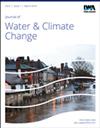长江中游流域极端降水的气候特征和主要天气模式
IF 3.1
4区 环境科学与生态学
Q2 WATER RESOURCES
引用次数: 0
摘要
基于长江中游流域(MYRV)1981-2018年40年的日降水量资料和ERA5再分析资料,利用统计方法分析了极端降水的气候特征。采用多元经验正交函数和谱聚类方法对极端降水天气进行分类和综合分析。结果表明(1)受区域地形影响,极端降水阈值的空间分布不均匀。平均降水量和极端降水日频率的空间分布呈南北反相分布。(2)按主要影响系统划分,近 40 年 MYRV 的 215 个区域极端降水日可分为三种类型:西南低涡型、台风型和冷槽切变线型。(3)西南低涡型极端降水发生在西南低涡槽前的深层暖湿气流中,但台风型的热动力条件较好,冷槽切变线型的冷暖气流辐合较明显。三种极端降水的降雨面积是系统协同作用的结果。本文章由计算机程序翻译,如有差异,请以英文原文为准。
Climatic characteristics and main weather patterns of extreme precipitation in the middle Yangtze River valley
Based on the daily precipitation data and ERA5 reanalysis data of 40 years from 1981 to 2018 in the middle Yangtze River Valley (MYRV), the climatic characteristics of extreme precipitation are analyzed using statistical methods. The multivariate empirical orthogonal functions and spectral clustering methods are used to classify and synthesize the extreme precipitation weather. The results show that: (1) The spatial distribution of the extreme precipitation threshold is uneven due to the regional topography. The spatial distribution of the average precipitation and frequency of extreme precipitation days is characterized by the north-south antiphase distribution. (2) According to the main influencing systems, the 215 regional extreme precipitation days in the MYRV in the past 40 years can be classified into three types: southwest vortex type, typhoon type, and cold trough shear line type. (3) The southwest vortex type of extreme precipitation occurs in the deep warm and humid airflow in front of the southwest vortex trough, but the typhoon type has better thermal dynamic conditions, and the cold and warm airflow convergence of the cold trough shear line type is more obvious. The rainfall area of three types of extreme precipitation is the result of the synergistic effect of the system.
求助全文
通过发布文献求助,成功后即可免费获取论文全文。
去求助
来源期刊

Journal of Water and Climate Change
WATER RESOURCES-
CiteScore
4.80
自引率
10.70%
发文量
168
审稿时长
>12 weeks
期刊介绍:
Journal of Water and Climate Change publishes refereed research and practitioner papers on all aspects of water science, technology, management and innovation in response to climate change, with emphasis on reduction of energy usage.
 求助内容:
求助内容: 应助结果提醒方式:
应助结果提醒方式:


